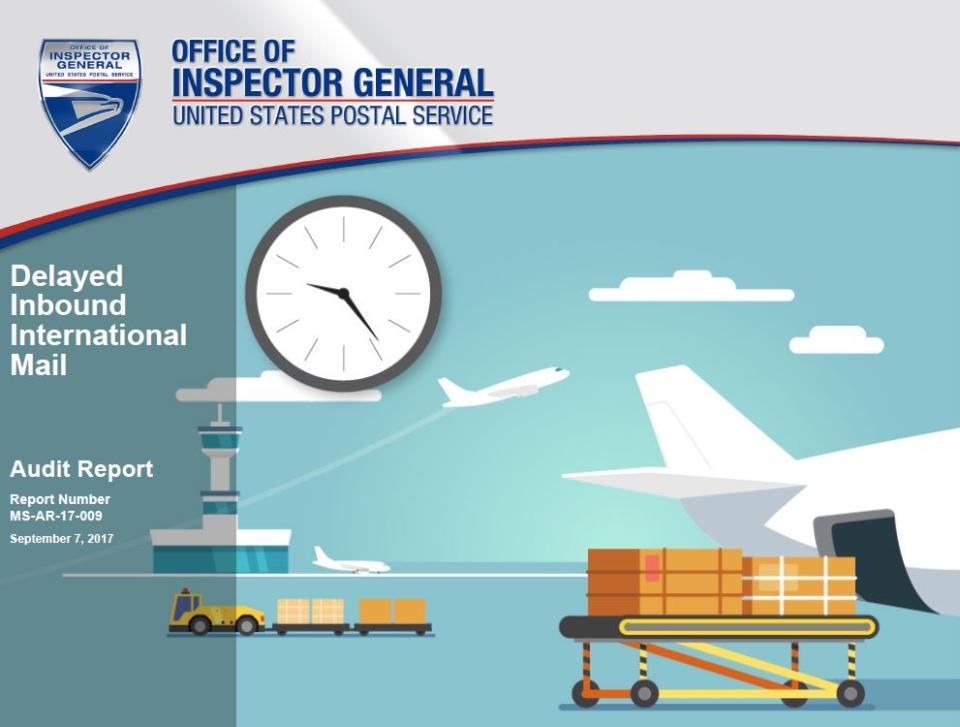Delayed Inbound International Mail
Background
About 621 million pieces of international mail entered the U.S. from foreign countries in fiscal year (FY) 2016. More than 95 percent of this mail was accepted by the U.S. Postal Service at one of its five International Service Centers (ISC) in San Francisco, New York, Los Angeles, Miami, and Chicago. The remaining segment was mostly accepted at either the Honolulu Processing and Distribution Center or the New Jersey International Network Distribution Center.
When inbound international mail arrives at airports via inbound commercial carrier flights, ground handlers (which can either be employees of the respective airlines or contracted employees of the airlines) unload the receptacles of mail from the airplane and tender them to the ISC. These initial operations mainly fall under the responsibility of the foreign postal operators and their agreements with the air carriers or ground handlers.
Postal Service employees monitor the airfield to assess the status of inbound international mail receptacles and manually document their assessments by completing reports known as ramp reports. Employees use these reports to document key mailing information including the airline, the country of origin, the foreign dispatch date (the date when the mail is scanned and assigned to a flight in the foreign country), and the number of receptacles waiting to be brought to the ISC.
The Universal Postal Union (UPU) Letter Post Manual states that mail should be tendered at the ISC within one to two hours maximum after the airplane’s arrival. Our objective was to evaluate the timeliness of mail arrival at the Postal Service’s ISCs.
What the OIG Found
We found significant delays in the Postal Service’s receipt of inbound international mail at the ISCs. Our analysis of all 5.4 million receptacles received at the ISCs between April 1, 2016, and March 31, 2017, with flight log data, showed the following:
- About 4.3 million receptacles, or about 80 percent of the mail tendered to the Postal Service, exceeded the 2-hour UPU guidance.
- Of these 4.3 million receptacles, about 63 percent arrived between 2 and 12 hours; about 20 percent took between 12 and 24 hours, and about 17 percent took longer than 24 hours.
- Delays were more prevalent during the end-of-year peak mailing season.
These delays occurred because airport ground handlers did not transport the mail to the ISCs in a timely manner after the flights arrived. While the Postal Service does not have the authority to manage the ground handlers, it has opportunities to improve its monitoring of the delays. Specifically, the Postal Service’s ramp reports are not being completed consistently across all ISCs. In addition, available data — such as the actual flight arrival date and time the mail arrives at the airport to better indicate how long a receptacle has been in the U.S. — is not incorporated into its inbound mail monitoring and reporting processes.
The Postal Service is coordinating with the foreign postal operators, ground handlers, and others on notifying the respective parties of the delays and developing corrective actions. These actions should help improve the identification and movement of delayed mail by increasing the visibility and awareness of the issue. As such, we are not making a recommendation to increase coordination.
Continued inbound international mail delays present service and public safety and security concerns, both of which could reflect poorly on the Postal Service’s brand and image. For example, we found instances where the delayed mail at one ISC resulted in rain-damaged and unsecured mail. In addition, Postal Service acceptance operations are structured to more efficiently handle timely, steady streams of incoming mail; delayed and clustered mailings tend to produce more inefficient inbound mail operations.
What the OIG Recommended
We recommended management develop a consistent ramp reporting process across all ISCs and a mechanism for incorporating available data into its inbound mail monitoring and reporting processes.

